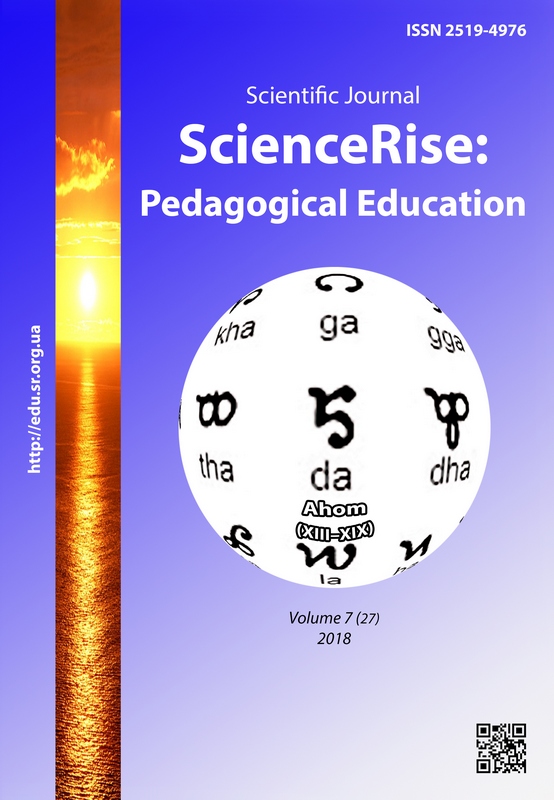Methods and forms of tutoring and mentoring at higher educational establishments of Germany
DOI:
https://doi.org/10.15587/2519-4984.2018.152388Keywords:
tutor, mentor, tutorial, qualification of tutors, quality assurance in educationAbstract
The article analyzes the methods and forms of tutoring and mentoring at Higher Educational Establishments (HEEs) of Germany. The study includes a comparative analysis of various German HEEs, the common features and differences in the implementation of tutoring and mentoring. It is noted that Germany is among the countries in which the system of tutoring and mentoring is implemented at the highest level, taking into account the peculiarities of different HEEs. It should be noted that the Network of Tutors plays a special role in coordination of tutors and mentors work at Higher Educational Establishments of Germany. The Network provides communication between specialists of various HEEs. It is responsible for complex situations solving and develops a strategy for the following years. The qualification of tutors deserves particular attention. Despite the differences in the system of tutoring and mentoring at different HEEs, there are general principles of functioning in line with the autonomy of each HEE. Much attention is paid to the training of tutors, since mentors are, in the majority of cases, employees of HEEs, they perform organizational and psychological functions and are specialists in accordance with their educational and qualification level. Tutors have a series of qualifying events, seminars and trainings. Eventually they get certificates. During trainings and training modules for tutors, they are not only taught the teaching methods, but also learn case-methods for solving specific problems. This is due to an increase in the number of foreign students and the need for non-standard approaches in work with foreigners. The article also reflects shifting emphasis in tutoring and mentoring activity. If the end of the twentieth century is characterized by the emergence of tutoring and mentoring in most of the HEEs, the beginning of the XXI century – by the systematicity of tutoring and mentoring, and today the emphasis is on the qualifications and certification of tutors. The article shows that the readiness level of tutors to conduct tutorials directly affects the success of students and quality assurance in the educational process
References
- Pleschova, G., Simon, E., Quinlan, K., Murphy, J., Roxa, T., Szabo, M. (2012). The professionalization of Academics as Teachers in Higher Education. Standing Commettee for the Social Sciences (SCSS). Science Position Paper, 32.
- Kröpke, H., Brinker, T.; Eckehard, M. (Ed.) (2008). Das Tutorenprogramm an der Hochschule Niederrhein. Wer, wo, wie und wie viele Schlüssel-Kompetenzen? Wege und Erfahrungen aus der Praxis an Hochschulen. Recklinghausen.
- Kröpke, H., Szczyrba, B.; Behrendt, B., Voss, H.-P., Wildt, J. (Eds.) (2006). Wer stützt den Sherpa? Tutorenweiterbildung als Investition in Qualität der Lehre. Neues Handbuch Hochschullehre (Griffmarke F 6.5). Stuttgart: Raabe, 2006.
- Wörner, A. (2006). Lehren an der Hochschule. Eine praxisbezogene Anleitung. Wiesbaden: Verlag für Sozialwissenschaften.
- Мaliarchuk, О. V. (2009). Vykladach v systemi dystanciynoho navchannia [Teacher in the system of distant learning]. Pedagogical process: theory and practice, 2, 169–178.
- Netzwerk Tutorienarbeit an Hochschulen. Available at: http://www.tutorienarbeit.de/
- The Mittelhessen Univeristy of Applied Sciences. Available at: https://www.thm.de/site/
- University of Wuerzburg. Available at: https://www.uni-wuerzburg.de/en/university/
- Fulda University of Applied Sciences. Available at: https://www.hs-fulda.de/en/
- Ruiz, N., Fandos, M. (2014). The role of tutoring in higher education: improving the student’s academic success and professional goals. Revista Internacional de Organizaciones, 12, 89–100. doi: http://doi.org/10.17345/rio12.89-100
Downloads
Published
How to Cite
Issue
Section
License
Copyright (c) 2018 Oksana Ivanytska

This work is licensed under a Creative Commons Attribution 4.0 International License.
Our journal abides by the Creative Commons CC BY copyright rights and permissions for open access journals.
Authors, who are published in this journal, agree to the following conditions:
1. The authors reserve the right to authorship of the work and pass the first publication right of this work to the journal under the terms of a Creative Commons CC BY, which allows others to freely distribute the published research with the obligatory reference to the authors of the original work and the first publication of the work in this journal.
2. The authors have the right to conclude separate supplement agreements that relate to non-exclusive work distribution in the form in which it has been published by the journal (for example, to upload the work to the online storage of the journal or publish it as part of a monograph), provided that the reference to the first publication of the work in this journal is included.








